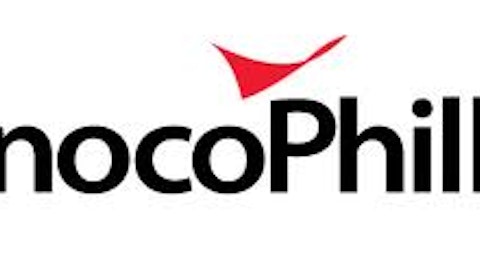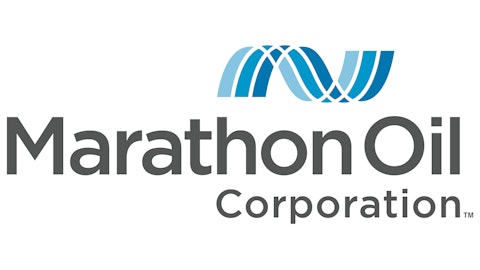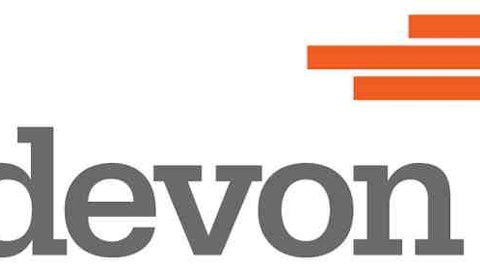Exploration and production company ConocoPhillips (NYSE:COP) held its annual investor day on Feb. 28. Among the many topics covered was how the company plans to grow its production over the next few years. Because of the natural decline of an oil and gas well, Conoco needs to invest nearly $35 billion over five years to mitigate that decline both in its international operations and here at home. Unfortunately, all that money spent developing current production is just enough to keep that production steady. In order to grow, the company is spending an additional $16 billion over five years on major projects so that it can meet its ambitious goals to grow production by 3% to 5% annually through 2017. Let’s drill down and see what ConocoPhillips (NYSE:COP) has in the works.

With more than 1 million net acres and seven major projects under way, ConocoPhillips is looking to become a major player in the Canadian Oil Sands. The company has a five-year investment plan totaling about $5 billion, which should double production here by 2017. The biggest production boost will be seen when phase 2 of its Surmont project comes online in 2015. The project, which is a 50% joint venture with TOTAL S.A. (ADR) (NYSE:TOT), is expected to produce 110,000 barrels of oil per day when complete.
For perspective, that’s about twice the production of Devon Energy Corp (NYSE:DVN)‘s Jackfish 1 and 2, which currently produces 48,000 barrels of oil per day. That’s nothing against Jackfish — production there is up more than 40% year over year. Despite recent challenges in takeaway capacity out of the oil sands, this is one of the best oil plays in North America. If the Keystone XL pipeline from TransCanada Corporation (USA) (NYSE:TRP) is finally approved, it would be a big help in getting this oil to our refiners and bypassing more expensive railway transport options.
U.K.
ConocoPhillips (NYSE:COP) should begin to see a boost out of its U.K. production as its Jasmine project comes online. The company is spending $2.5 billion on this and other projects in the area. Once complete next year, these projects should drive incremental production of more than 55,000 barrels of oil equivalent per day. Jasmine, which is the largest recent discovery in the U.K., is the fourth project developed out of its J-Block, with first production expected to come online later this year.
Norway
ConocoPhillips (NYSE:COP) sees major projects driving production in Norway for more than 40 years. Its five-year investment plan totals $4 billion, with its Ekofisk South and Eldfisk projects being a big driver of additional production. The Greater Ekofisk Area, which is a co-venture with Total and Statoil ASA(ADR) (NYSE:STO) among others, will gradually ramp up production by nearly 60,000 barrels of oil equivalent per day by 2017. This is a great asset as production will be tied to Brent crude pricing, which will be an important driver for Conoco’s margins and profits.
Malaysia
Conoco’s projects in Malasyia are ramping up over the next year, with production eventually growing by 70,000 barrels of oil equivalent per day by 2015. With four developments in the works, the company’s spending is on par with its U.K. investment of $2.5 billion over five years. However, there’s additional upside here for future growth beyond what’s already in the plans. As with any oil and gas project, the opportunity to capture upside over time will be important as it will help to offset the declines seen elsewhere.
Australia Pacific LNG
The final major project in development is an LNG export facility in Australia. Conoco owns a third of the facility, which is scheduled to begin operations in 2015. The facility, which will initially have two export trains, is permitted for two additional trains. While we still debate the merits of LNG exports here in the U.S., in places such as Australia and Mozambique, operators are developing large-scale LNG export facilities to get the gas from production basins to the world market. Only time will tell if we’ll join them to the same degree.
My Foolish take
When you add up all these major projects, they should drive 400,000 barrels of oil per day of production growth by 2017. With all of these projects targeting high-margin oil or LNG, ConocoPhillips should easily hit its targeted range of 3% to 5% growth in both production and margins over the next few years. As a ConocoPhillips shareholder, that’s exactly what I want to hear.
The article Where Is the Major Growth at ConocoPhillips Coming From? originally appeared on Fool.com and is written by Matt DiLallo.
Fool contributor Matt DiLallo owns shares of ConocoPhillips. The Motley Fool recommends Statoil (ADR) and Total SA. (ADR). The Motley Fool owns shares of Devon Energy.
Copyright © 1995 – 2013 The Motley Fool, LLC. All rights reserved. The Motley Fool has a disclosure policy.





